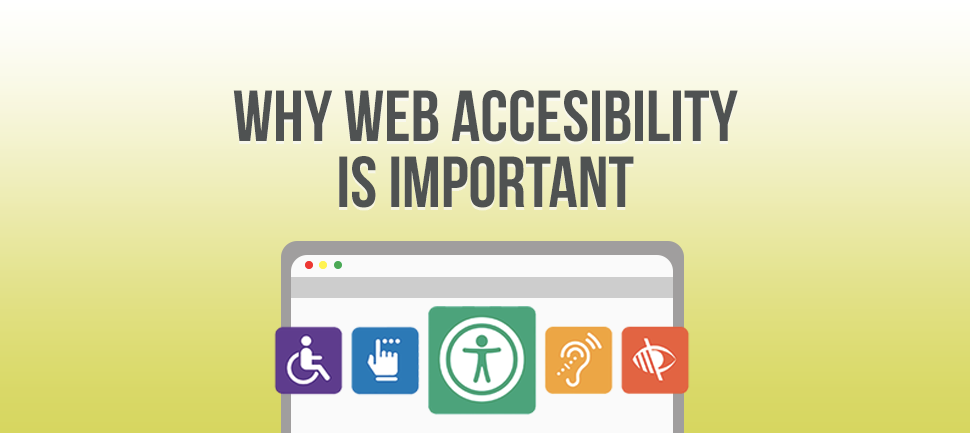Today, web accessibility is key to creating a more inclusive society by eliminating barriers that restrict a person's access to jobs, housing, civic participation and much more.
The truth of the matter is that web accessibility often goes unnoticed which makes it more difficult for people with disabilities (1 out of 5 Americans and 1 out of 6 EU citizens) to gain equal access to the online world and its rich bounty of resources.
What is Web Accessibility?
Web accessibility or digital accessibility is the ability for an app, website, or software to be accessible to people who have a disability that affecting their vision, hearing, cognition, and/or motor functions.
To help people with disabilities, there are several kinds of assistive technology tools (software and hardware) that make it easier to navigate a website and interact with its content. Some examples of these tools include screen readers, alternative keyboards and/or trackpads, screen magnifiers, eye tracking tools, and more.
These assistive tools works in a similar manner to that of a service animal in that it helps you navigate and interact in an environment that, by nature, poses challenges as a result of a disability.
Websites that are not compatible with assistive technology tools are like shopping centers refusing access to someone with a service animal. Without the software or animal, the person is faced with greater challenges and hurdles that discourage them from using the space.
How to Improve Web Accessibility
As an aspect of the user experience (UX), developers can improve the website accessibility by employing the Universal Design Principles when building or redesigning a website. Doing so can ensure the disabled community can access a particular website with the help of their assistive technology.
- Equitable Use: The design is useful and marketable to people with diverse abilities.
- Flexibility in Use: The design accommodates a wide range of individual preferences and abilities.
- Simple & Intuitive Use: Use of the design is easy to understand, regardless of the user's experience, knowledge, language skills, or current concentration level.
- Perceptible Information: The design communicates necessary information effectively to the user, regardless of ambient conditions or the user's sensory abilities.
- Tolerance for Error: The design minimizes hazards and the adverse consequences of accidental or unintended actions.
- Low Physical Effort: The design can be used efficiently and comfortably and with a minimum of fatigue.
- Size and Space for approach and Use: Appropriate size and space is provided for approach, reach, manipulation, and use regardless of user's body size, posture, or mobility.
Additionally, development teams can also follow the Web Content Accessibility Guidelines (WCAG) to ensure people with a wide variety of disabilities can access and use their sites, apps, and more.
Why Web Accessibility is Important?
Web accessibility is not only ethical but also a sound business practice as well as a legal obligation.
Economically, ignoring the disabled community means ignoring millions of potential customers with billions in purchasing power. In the United States alone, the purchasing power of assistive-technology Internet users is worth more than $350 billion.
After considering the size of this community across the rest of the Americas, Europe, and elsewhere, it is clear that ignoring this demographic would be a mistake.
In many places, web accessibility protected under various laws. In the U.S., the Workforce Rehabilitation Act of 1973 requires that all “electronic and information technology developed, procured, maintained, or used by the federal government be accessible to people with disabilities.”
Also, the Twenty-First Century Communications and Video Accessibility Act requires that advanced communications services and products to be accessible by people with disabilities.
Although many European states have their own national laws outlining the protections for web accessibility, the European Union too protects digital accessibility under the European Charter of Fundamental Rights. As a result, web accessibility is an important requirement that all need to meet.
Article 11 - Freedom of Expression and Information
Everyone has the right to freedom of expression. This right shall include freedom to hold opinions and to receive and impart information and ideas without interference by public authority and regardless of frontiers.
Article 21 - Nondiscrimination
Any discrimination based on any ground such as sex, race, colour, ethnic or social origin, genetic features, language, religion or belief, political or any other opinion, membership of a national minority, property, birth, disability, age or sexual orientation shall be prohibited.
Article 26 - Integration of Persons with Disabilities
The Union recognises and respects the right of persons with disabilities to benefit from measures designed to ensure their independence, social and occupational integration and participation in the life of the community.
Recommendation: Execute Web Accessibility Tests
While following the principles above is essential for web accessibility, the importance of quality assurance testing cannot be underestimated.
Executing web accessibility tests is the only way to uncover bugs or design flaws on a website that can make it inaccessible to people who rely on assistive technology. Web accessibility tests are also key to uncover issues that contribute to a disappointing user experience.
To learn more about web accessibility testing, please do not hesitate to download our white paper on this topic.







